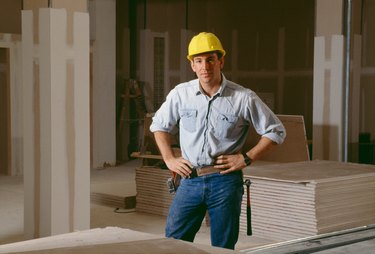
Drywall, also called gypsum board or sheetrock, is a construction material made from gypsum plaster and thick paper. It is the product most commonly used to make walls and ceilings in modern homes. This product is fairly easy to hang, but requires some skill in order to complete the installation properly. Though drywall is extremely durable, bulges occasionally arise. These bulges are the result of underlying issues, most often water damage. Proper preparation and repair will help fix this imperfection.
Water Damage
Video of the Day
Water damage is a serious problem to any part of the home, and leaves affected spaces open to increased mold growth and several other adverse problems. Water problems will often leave warning signs, and in drywall bulges are telltale signs. Additional signs include discoloration and a softening of the drywall, often found alongside water stains on the ceiling or buckling floors. Prior to fixing the drywall, the water source, whether it be a leaky pipe or roof, must be repaired and the area allowed to dry.
Video of the Day
Loosening
Loosening drywall is another reason bulges appear. Loosening means the material is pulling away from the studs, which will cause bulges or blisters in the drywall. Additional blistering often becomes evident along the seams where two pieces of drywall meet, and where the tape and compound are present. The website askthebuilder.com indicates that the most common cause of blistering in drywall tape is improper application; most often a lack of joint compound between the tape and drywall.
Securing Bulges
For drywall that has become loose, securing it is usually the best solution. Locate the studs on either side of the bulge. This can be done by using an electronic stud finder. Drilling a few screws into the drywall will secure it back to the studs and is the simplest method for repairing the bulges caused by loosening. Nail head are easily covered with a layer of drywall compound. If bulging is present in the ceiling and is not the result of water damage, additional bracing between the studs will add more security to the drywall. This bracing is as simple as a 2x4 board placed between the joists over the bulge.
Replacing
If water damage is the cause of bulges and blisters, replacing the drywall is usually going to be the safest option. A partial replacement is ideal when the blistered area is small, and requires removing and replacing the damaged areas. More serious damage will require an entire sheet of drywall to be replaced. Cut out a square slightly larger than the damaged area using a drywall saw. Use 3-inch anchor blocks to screw a new piece of drywall into place. Put drywall tape along all sides of the new drywall and top it with a thin layer of drywall compound. Once that first layer has dried, apply a second layer. Wait until it is dry, then sand it smooth. All leaks and other water problems should be corrected and the area dried prior to replacing the drywall.
- Sophisticated Edge: How to Repair Water Damaged Drywall
- Restoration SOS: Identifying Water Damage; Kimberly Duncan; Nov. 16, 2006
- "Popular Mechanics"; Drywall Repair; Merle Henkenius; Feb. 17, 2005
- Handy Man Fix Home Repair: Dealing With Drywall Damage; July 2, 2011
- Drywall Tips: Install Drywall on a Ceiling